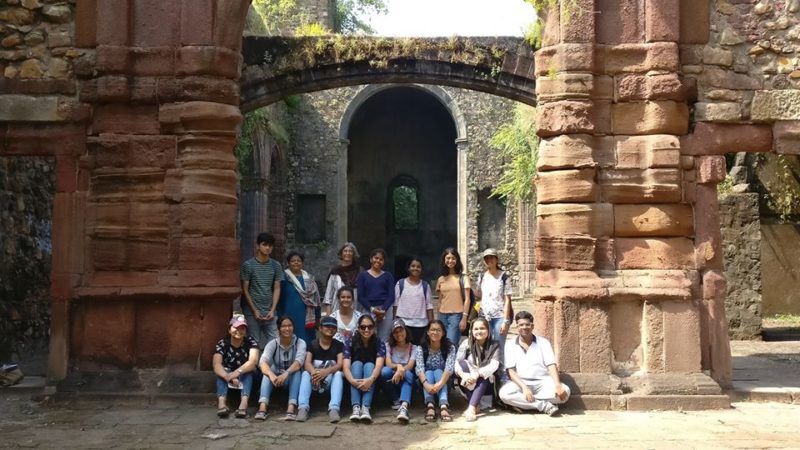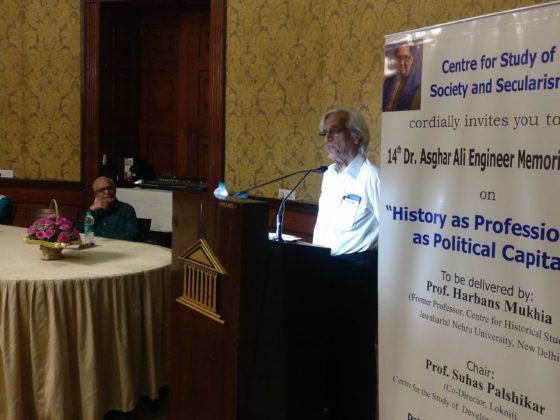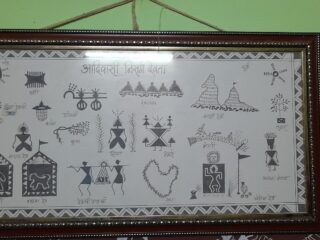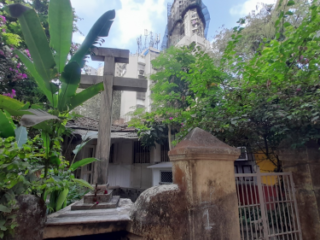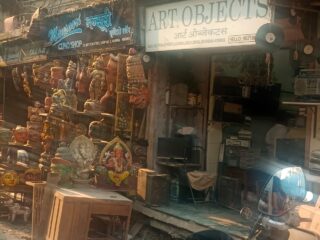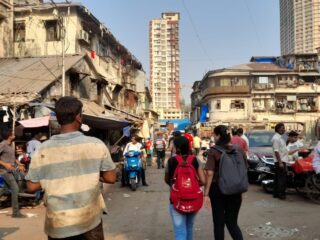Report by Rahman Safdar and Tavishi Ahluwalia
“Exploring Diversity in Mumbai Course” was conducted by the Centre for Study of Society and Secularism (CSSS) in collaboration with the Department of Interreligious Studies, St. Xavier’s College, Mumbai spanning across thirteen days from 23rd October – 11th November 2019. A batch of sixteen students from various disciplines participated in the course and brought their unique perspectives in exploring the complex socio-cultural space of the city.
The global political landscape is witnessing an important period of transformation as evident from the resurgence of neo-fascism in Western Europe, the emergence of xenophobia and anti-immigration politics in the USA and the predominance of cultural nationalism and majoritarianism in India. These trends reflect a growing polarization in society on the basis of religion, race, ethnicity, language, ideology, etc. Thus, an understanding of the dynamic historical, social and political processes that shape diverse identities is the need of the hour. This assumes special significance for a young nation-state like India where modern constitutional values often come in conflict with social hierarchies. The various competing discourses on secularism, multiculturalism and the rights of minorities, Dalits, Adivasis, women and LGBTQ+ community often arise from disagreements on how diversity is understood. The vision of the course is to enable young minds to engage with the question of diversity which has emerged as one of the most defining political debates of our times. The course aims to equip students with basic knowledge of various aspects of diversity and inspire them to question the social realities around them. The course structure is designed to integrate academic lectures with field visits to enable a holistic understanding of how the city is characterized by a myriad of social, political and economic interactions taking place within a particular historical context and political discourse.
The course explored the various dimensions of diversity through the following modules which included lectures and field visits.
Understanding Identities and Diversity
The introductory lecture was delivered by Irfan Engineer, Director of the Center for Study of Society and Secularism(CSSS). He urged the students to reflect on “Whether differences always lead to competition and antagonism between diverse groups or whether differences can become an opportunity for the exchange of plural ideas to holistically understand reality?”.Throughout his lecture and interactions he tried to familiarize the students with the various examples of religious and cultural diversity which exists in India. India has been the cultural hotspot since ancient times. People from various parts of the world came to the Indian subcontinent at various times in history, leading to the creation of a multi-ethnic and multicultural Indian society. The spirit of multiculturalism and celebration of diversity can be found in the works of various bhakti and Sufi saints which Mr Engineer quoted to demonstrate how diversity was accommodated in medieval times. Dr Nasreen Fazalbhoy, Reader, Department of Sociology, University of Mumbai asked the students to ponder upon the question of cultural hegemony and the persistent threat of marginalization of minority cultures. She emphasized how the spirit of not just tolerance but a sincere acceptance and respect of the differences is needed. The lectures were followed by a visit to Mahim. The region of Mahim has a Dargah, a Church and a temple in close vicinity to each other. Students visited the Dargah and the Church to better understand the aspect of inter-religious ties and various means by which communities come together and find ways of coexistence.
Understanding Challenges to Diversity
Professor Kamala Ganesh from the Department of Sociology, University of Mumbai gave a lecture on “Understanding Challenges to Diversity”. She described how diversity is an existential condition and how societies evolve ways of managing diversity while also juggling with compulsions of bringing social order to reign in perceived anarchy and chaos, “The push for unity/unification and the need to nurture diversity are dialectically connected impulses in society.” Her lecture touched upon the religious, linguistic, caste, regional and ethnic dimensions of diversity in Indian society and how interactions within this diverse society can be understood through concepts of acculturation, assimilation, integration and syncretism. Her lecture provided a sociological understanding of the various developments in contemporary society eg. the rise of Hindutva in India, Dalit political assertion and the violent backlash etc. Her lecture made students reflect on how diverse societies can move towards common goals without homogenization and without creating hegemony of the majority culture.
Ghettoization in Mumbai/ Visit to Mumbra Rehnuma Library
Professor Ranu Jain from Centre for Studies in Sociology of Education, TISS Mumbai, was invited to give a lecture on Ghettoization in Mumbai. Her lecture enriched students’ understanding of the factors which lead to the formation of ghettos. She explained her field study of Mumbra, a Muslim ghetto in Mumbai. In her view, “A sense of collective security incentivizes the minority community to reside in geographical space and the antagonistic population surrounding them provides the social barrier that enforces confinement.” She also emphasised on the problems of the current developmental discourse vis-a-vis ghettos. The neoliberal development paradigm focuses primarily on creating tangible infrastructure. This forces the ghettos to the margins of the expanding city where civil infrastructure and state services have not yet reached. Such development initiatives fail to address inter-community relations and fail to take into consideration the insecurities of the minority Muslim community and the discrimination in accessing the city infrastructure which creates such ghettoes in the first place. As a part of the field study, students visited the Mumbra Rehnuma Library centre which functions as a reading room for women. It was started in 2003 by Awaz-e-Niswan (Voice of Women), a feminist collective and organization that works for the rights of Muslim women. The library has a vast collection of books from Ismat Chugtai to the Harry Potter series and provides a space of freedom for women to explore, learn and discuss. The students had the opportunity to interact with the inspirational Saba Parveen who is a football coach for the all-girls team in Mumbra and was one of the first women in Mumbra to take up the sport. She shared her personal journey from being a timid girl to a fiercely independent and accomplished woman through the medium of sport. She emphasized the challenges that women face when they decide to move beyond ascribed gender roles to define their own lives. She also spoke about the discrimination she faces along with countless other residents of Mumbra due to growing Islamophobia. This interaction helped students understand how unconscious biases often manifest as active discrimination and othering of minorities leading to marginalization and exploitation.
Mills and Working Class in Mumbai
Ms Neera Adarkar, writer and a prominent social worker who has worked extensively on mills and worker movements in Mumbai was invited to give a lecture on Introduction to Mills and Working Class in Mumbai. An architect by profession, she emphasised on the correlation of architecture and the socio-economic diversity in the Mumbai city. She traced the history of the current face of Mumbai using architecture to understand various phases of migration. Textile mills sprang up in Mumbai owing to the global demand for Indian cotton and the presence of raw material from the cotton belts in Maharashtra. However, post-colonial international policies such as the Multi-fibre arrangement imposing quota ceiling on developing nations along with national policies such a differential excise duty and promotion of khadi and handloom led mills to become a loss-making enterprise. Ms Adarkar delved into the issue of inequitable liquidation of the mills by the mill owners. The skilled workers lost their livelihood due to the closing of the mills and were pushed into the informal workforce and unauthorised dwellings. Their chawls along with the mill land are being converted into other enterprises owing to the loopholes in the Development control rules, forcing many to shift to slums. She also remarked how neoliberal policies are reshaping the urban landscape of Mumbai making it lose its distinct identity and unique urbanism. The students reflected on the fact that the built environments represent unique cultural preferences and aspirations. However, the new infrastructure is reflective of planning of global capitalism which has little relation to the local context.
Subaltern Narratives: Dalits in Mumbai
Professor Avatthi Ramaiah from the Centre for Study of Social Exclusion and Inclusive Policy, Tata Institute of Social Sciences, Mumbai gave a lecture on “Subaltern Narratives: Dalits in Mumbai”. His lecture emphasized that caste is a system of ascriptive stratification which organizes the society into a hierarchy of closed endogamous groups. Professor Ramaiah also provided examples from the scriptures and texts like Manu Smriti which sanction a social order based on the exploitation of Shudras, Avarnas and women. He made students reflect on the question of divine will versus human rationality and the historical evolution of religion. The students visited a Dalit Basti in Vakola with Dr Sandhya Mhatre. The session helped students understand how caste hierarchies result in the unequal distribution of material and social resources. This is reflected in the fact that Dalits and Adivasis consistently fare worse in human development indicators such as life expectancy at birth, infant mortality, maternal mortality and school drop out rates. Political marginalization of Dalits is seen from the token appearance of Dalit issues in election manifestos while their cultural marginalization is seen in the suppression of Dalit symbols and their versions of history. This session made students reflect on the inequity that persists in the society due to the design of social structures which bestows advantages on certain groups while simultaneously restricting the freedom and opportunities of others.
To hold a talk on Popular Cinema and Diversity in Mumbai, Mr Anjum Rajabali, a veteran Indian screenwriter and teacher was invited. Rajabali started the lecture by enumerating the diversity of languages, ideas, views, opinions and socio-cultural contexts from which people come to the Indian film industry. However, he went beyond such shallow portrayal of Bollywood as a celebrator of colours and diversity. There is little doubt that the film industry creates some space for exceptional talent to rise from rags to riches but it is not the defining feature of this industry. The concentration of power and resources in the hand of few goes against the creation of a diverse and vibrant industry. Out of the box scripts have mostly been discouraged by the powerful film producers who are driven by commercial motives which have homogenizing tendencies on the filmmaking process. He also problematized the portrayal of women, Muslims, transgender persons in Indian Cinema which often reinforces common stereotypes. Rajabali also talked about the influence of politics and communalism in cinema post-1992 Bombay riots. However, he was hopeful of emerging trends in parallel cinema which got a breath of fresh air with directors such as Hansal Mehta, Shojit Sircar, Anurag Kashyap to name a few. According to him, movies are becoming more contextualised and narrate a very specific social reality which gives the filmmaker greater opportunity to vividly portray diverse socio-cultural realities. His lecture provided insights into the changing nature of Indian Film industry and helped students understand how cinema emerges within a particular social context and can become a tool to restrengthen the existing power hierarchies and legitimize the status quo. He thus urged students to reflect on the true meaning of art, the linkages between art and ideology and how art should show a mirror to the society by giving voice to the most oppressed and marginalised.
Professor Aravind Ganachari, former head of Department of History, University of Mumbai gave an insightful lecture titled “Introduction to History of Mumbai”. The lecture provided a detailed chronology of the development of the city from the Kolis and Aagris being the original inhabitants to the Portuguese possession after the Treaty of Bassein. Mumbai emerged as an important trading town under British colonialism. Thereafter, Mumbai became an important centre for the Indian national movement. After independence, Mumbai emerged as an economic powerhouse and the commercial capital of India. Professor Ganachari systematically demolished the myth of British benevolence and showed through various examples in history that the British investment in infrastructure was only directed towards more efficient administration and extraction of native resources. The lecture also described the racial segregation in the city where certain regions like Malabar Hills were barred for the native Indians. The lecture emphasized the aspect of migration and the contribution of the diverse migrant communities in the making of the city. He showed how Indians contributed towards the creation of various assets that are seen as identifiers of the city today. For instance, Elphinstone College was funded by public subscription, Sassoon Docks was built in 1875 on reclaimed land by the company of David Sassoon who was a Baghdadi Jewish leader in Bombay. Similarly, Rajabai Clock Tower was built with the help of donations from
Premchand Roychand and The Institute of Science was constructed using funds from private donations by Indian businessmen. The lecture also provided insights into how interactions between various migrant communities like the Tamil Brahmins, Telugu workers, Konkan workers along with migrants from North Indian states led to the emergence of new traditions of folk theatre and art. The cosmopolitan culture of the city attracted many members of the Progressive Writers’ Movement that produced one of the greatest and most radical work in the history of the subcontinent. The lecture ended with Professor Ganachari stating that Mumbai has emerged as a city which is “united by its future” as people belonging to different historical contexts find a sense of belongingness in their shared hopes for a better future. In order to further enrich the students understanding about the history and diverse culture of Mumbai, visits to Dr Bhau Daji Lad Mumbai City Museum, Mani Bhavan, Bhendi Bazar, Chor Bazar, Vasai and Mazagaon Dock were organised.
A visit to Mazgaon Dock and Vasai
Veteran journalist Rafique Baghdadi who is often called “the storyteller of Mumbai” facilitated the Mazgaon visit for the students. This visit enabled the students to witness the confluence of cultures across space and time. The presence to the Shah Hasan Ali Maqbara which is revered by the Nizari Ismailite sect of the Shiite Muslims, Our Lady of the Rosary Church, the Kwan Kung Temple built by See Yup Koon community from Canton in Southern China helped students understand how the composite history of a city cannot be interpreted from a monolithic framework of native-migrant binary. In Vasai, the students visited Fort Bassein which gave an insight into the Indo-Portuguese history. This was followed by an interaction with the fisherfolk community which helped students understand the various challenges faced by the Koli fishing community ranging from depleting fish stocks to uncertain market conditions.
Bhendi Bazar: Revisiting Manto
The visit to the Bhendi Bazaar was facilitated by a literary and cultural organisation ‘Urdu Markaz’. Zubair Azmi, director of the organization guided the students through the lesser-known landmarks like Wazir Hotel where progressive Urdu writers like Manto, Kaifi Azmi, Majrooh Sultanpuri, Ali Sardar etc once frequented. The students also visited Manto’s home in what was formerly Adelphi House and discussed Manto’s revolutionary works and the power of storytelling. A visit to the Maktaba Jamia Ltd, the oldest Urdu bookstore in the city introduced students to the rich literary heritage of the language. They also gained insights into the declining readership from their interactions with the bookstore owners. The lack of quality Urdu medium schools and little avenues to learn Urdu as a second language in schools was raised as a concern.
Re-negotiating Spaces in Mumbai Women’s Contribution to Making of Mumbai
Ms Chayanika Shah, prominent LGBT and women’s rights activist was invited to deliver a lecture on Gender and diversity. She started with a discussion on the difference between the concept of sex and gender and how biological differences in sex are used as an argument to define gender roles and create gender stereotypes. She further delved into the underlying hierarchies in the social order and the role of patriarchy in creating and sustaining such unequal power relations in society. Ms Shah touched upon the topic of the fluidity of sexes and LGBTQ rights. Students were left to ponder on how Heteronormativity is entrenched in every structure of the society and not only perpetuates social exclusion and marginalization of women and other genders but also legitimises violence against them. To better understand the contribution of women in the making of Mumbai city and how women renegotiate spaces in the ever-expanding city, students made a visit to Keshav Gore Smarak Trust. The students interacted with the project head of SWADHAR, a family counselling centre. It functions as a one-stop centre for women in need of help and provides access to the services of doctors, counsellors, legal experts and police. This enabled students to understand the prevalence of domestic violence which is the manifest form of the patriarchal biases in the society. Later, students visited the livelihood promotion programmes for women facilitated by the Trust. It provided an insight into how women can organise themselves to acquire economic independence thereby furthering the cause of gender justice.
Diversity and Nationalism/ A visit to RSS Shakha
Dr Ram Puniyani is a human rights defender and a
former professor at the Indian Institute of Technology, Bombay (IIT Bombay). He
was invited to share his views on Nationalism and Diversity. Dr Puniyani helped
the students trace back the concept of nationalism in India. Nationalism
according to him is a modern concept which has its origin in 16th-17th century
Europe. In India, Nationalism is a product of British colonial policies.
Towards the latter half of the British Raj, there was the creation of two broad
classes according to Punyani namely the rising classes consisting of workers,
native industrialists and the modern educated middle-class and the declining
classes consisting of the landlords and the princess. The formation of these
two classes led to the development of two distinct articulation of nationalism.
The rising class articulation was based on the values of syncretism, tolerance,
democracy and social justice while the declining class articulated nationalism
in terms of homogenous racial and religious identities. The second articulation
thereby gave rise to Hindu nationalism and Muslim nationalism, culminating into
the partition of India. Puniyani’s talk was purposefully delivered to show
students the fluidity in the historical narrations. Dr Punyani warns that the
communal articulation of Nationalism in the form of Hindu nationalism is
against the spirit of the national struggle for independence. The talk was
followed by a subsequent visit to the RSS shakha at Santacruz. One of the
senior members of the Shakha held a talk about the history of RSS and the day
to day workings in the Shakha. After the talk, students posed certain questions
and tried to understand the articulation of nationalism, secularism, views on
the caste system and much more from the perspective of the right-wing. One of
the students, after looking at the portrait of Babasaheb Ambedkar hanging on
the wall asked the Shakha member how Ambedkar’s radical views on Hinduism and
annihilation of caste can be reconciled with Hindutva. The visit to the RSS
camp exposed the students to the complete spectrum of political ideologies
present in India. It also created an opportunity to hold a dialogue and
exchange of views between people from both ends of the spectrum which is the
need of the hour.
Subaltern Narratives: Adivasis in Mumbai/ A visit to Arrey Forest
Shiraz Balsara, a prominent activist and lawyer associated with the Kashtakari Sanghatana gave an insightful lecture on “Subaltern Narratives: Adivasis in Mumbai”. Her lecture focused on the tribal identity and the multiple dimensions of discrimination and deprivations faced by the Adivasis. She started her lecture by talking about some of the common stereotypes associated with Adivasis and how these stereotypes help in building the narrative of “civilizing the savage” through mechanisms like forceful integration by the State and Sanskritization. She emphasized how Adivasis, the original inhabitants, after facing centuries of exploitation are now relegated to the margins of the society. She used official statistics and her personal experiences of working with the Adivasis to show the abysmal levels of access to nutrition, healthcare, education and employment. The lecture provided insights into the grass root level issues in the implementation of the Forest Rights Act, issue of tribal displacement and rehabilitation, distress seasonal migration, exploitation of migrant workers and bonded labour. The lecture provided the students with an opportunity to question the concepts of development and progress that have become commonsense of our times. This lecture was supplemented by a field visit to Kelti Pada in Arrey Forest where the students had the opportunity to interact with tribal rights activist Prakash Bhoir. Mr Bhoir described the changing landscape of the Arrey Forest over time, with land being acquired for various infrastructure development programmes such as Bombay Veterinary College, SRPF, Force one and recently for the metro car shed. He raised questions on the prevalent model of development which he believes is endangering the lives and culture of the Adivasis. Development according to him presented the challenges of forced displacement and inadequate rehabilitation on one hand while on the other hand, it excluded the Adivasis from its fruits as seen in the lack of basic facilities like electricity and clean water supply in their hamlets. He further presented a damning critique of development that destroys the trees and the entire ecosystem of living beings residing in the forests as Vinaash (destruction) instead of Vikaas (progress). This visit enabled students to reflect on whether it is just to forcibly curtail the rights of the Adivasis to their land and their way of life in the name of larger social good of development.
The course concluded with the students making presentations on various topics like “History of Mumbai”, “Understanding Diversity” and “Challenges to Diversity”. The students incorporated their learnings from the lectures, discussions and field visits in their presentations and reports. Some of the students shared their personal journey and how the course helped them reexamine their preconceived notions and ideas.

